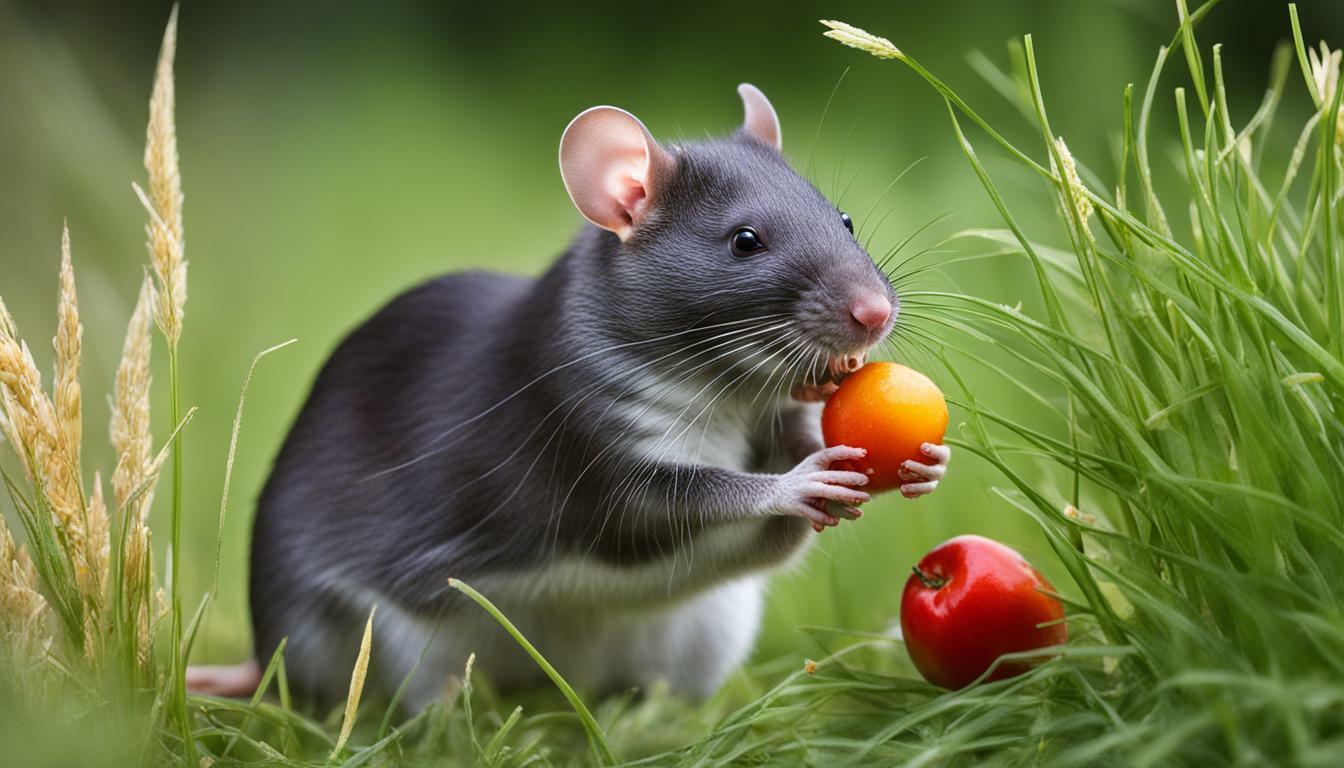If you’re wondering whether it’s safe for rats to eat timothy grass, we have the answer for you. Rats can indeed eat timothy grass, but it is not an essential part of their diet. While hay, including timothy grass, can provide nutritional value to rats, it is important to consider certain factors and safety considerations when feeding it to them.
Key Takeaways:
- Rats can eat timothy grass, but it is not necessary in their diet.
- Hay, including timothy grass, can provide nutritional benefits to rats.
- Different types of hay, such as alfalfa and timothy hay, can be fed to rats.
- Poor quality hay may contain molds that can cause digestive and respiratory issues in rats.
- Feeding timothy grass in moderation is important to prevent temporary loss of appetite and weight loss in rats.
Nutritional Value of Timothy Grass for Rats
Timothy grass can provide nutritional value to rats and play a role in their overall diet. This type of grass is rich in fiber, which is essential for rats’ digestive health. It helps maintain proper bowel movements and prevents constipation. Additionally, timothy grass contains essential vitamins and minerals that contribute to rats’ overall well-being.
Protein is an important component of rats’ diet, and timothy grass contains a moderate amount of it. Although it may not satisfy all of their protein requirements, it can still be a valuable source when combined with other protein-rich foods. This grass also provides rats with roughage, promoting dental health by aiding in the natural wear down of their constantly growing teeth.
When offering timothy grass to rats, it’s crucial to ensure its quality. Poor quality hay can contain molds that may lead to digestive and respiratory issues in rats. Therefore, it’s important to select hay that is fresh, free from molds and dust, and has been properly stored. Providing rats with clean and high-quality timothy grass will ensure they receive the maximum nutritional benefits without the risk of detrimental health effects.
| Type of Hay | Protein Content |
|---|---|
| Timothy Hay | 7-12% |
| Alfalfa Hay | 15-20% |
It’s worth noting that hay does not need to be the sole component of a rat’s diet. To make it more appealing, hay can be mixed with other foods such as fresh fruits, vegetables, and seeds. This variety ensures rats receive a well-rounded diet and helps prevent boredom or picky eating habits. It’s important, however, to feed hay in moderation. Overeating timothy grass can cause a temporary loss of appetite and weight loss in rats, so it’s crucial to provide it as part of a balanced diet.
Different Types of Hay for Rats
Alongside timothy grass, rats have various hay options to choose from for their diet. Hay provides essential nutritional value for rats, with different types of hay offering varying levels of protein content. Two popular choices for rat nutrition are alfalfa hay and timothy hay.
Alfalfa hay is rich in protein, making it a great option for rats that require extra protein in their diet. This type of hay can be a good choice for pregnant or nursing rats, as well as young rats that are growing and developing.
Timothy hay is another commonly available option that provides a balanced nutritional profile for rats. It contains a moderate amount of protein and is low in calcium, making it suitable for adult rats as part of a well-rounded diet.
| Type of Hay | Protein Content | Calcium Content |
|---|---|---|
| Alfalfa | 15-20% | 1-2% |
| Timothy | 6-12% | 0.4-0.6% |
It’s important to note that the quality of hay is crucial when feeding it to rats. Poor quality hay can contain molds that may lead to digestive and respiratory issues in rats. To ensure the safety of your pet, always choose fresh and mold-free hay from a reputable source.
When serving hay to rats, you can mix it with other foods to increase variety and make it more appealing. Fruits, vegetables, and seeds can be added to their diet alongside hay to provide additional nutrients and enrich their eating experience. However, it’s important to remember that feeding hay should be done in moderation. Overeating hay can cause a temporary loss of appetite and weight loss in rats, so be mindful of the amounts you offer and monitor your pet’s intake.
Safety Considerations When Feeding Timothy Grass to Rats
While timothy grass can be safe for rats, it’s important to be aware of certain considerations to ensure their well-being. Feeding timothy grass should be done in moderation, as overeating can lead to temporary loss of appetite and weight loss in rats. It is crucial to maintain a balanced diet and offer timothy grass as part of a varied food selection.
When providing hay to rats, it is recommended to opt for high-quality hay to minimize potential risks. Poor quality hay can contain molds, which can have adverse effects on rats’ digestive and respiratory systems. These molds can cause gastrointestinal issues and respiratory problems in rats, leading to discomfort and potential health complications.
To make timothy grass more appealing, it can be mixed with other rat-friendly foods. Adding fruits, vegetables, and seeds to the hay can enhance its taste and texture, encouraging rats to consume it. This approach helps ensure that rats are receiving a well-rounded diet that meets their nutritional needs.
| Considerations when feeding timothy grass to rats: |
|---|
| Feed in moderation to prevent overeating and maintain a balanced diet |
| Choose high-quality hay to avoid potential mold-related issues |
| Mix timothy grass with other rat-friendly foods to make it more appealing |
By following these safety considerations, you can provide timothy grass to your rats without compromising their well-being. Remember to monitor their appetite and weight to ensure they are maintaining a healthy lifestyle.
Mixing Timothy Grass with Other Foods
To make timothy grass more appealing to rats, it can be mixed with other foods such as fruits, vegetables, and seeds. This not only adds variety to their diet but also provides additional nutrients. Rats are omnivores, so incorporating a range of foods can help ensure they receive a balanced diet.
Here are some examples of foods that can be mixed with timothy grass:
- Fruits: Rats can enjoy small portions of fruits like apples, berries, and bananas. These provide natural sugars and antioxidants.
- Vegetables: Adding vegetables like carrots, broccoli, and leafy greens can provide essential vitamins and minerals.
- Seeds: Including seeds such as pumpkin seeds or sunflower seeds can offer healthy fats and protein.
Remember to introduce new foods gradually and monitor your rat’s response. Some rats may have preferences or sensitivities to certain foods, so it’s important to observe their reactions.
Here is an example of a mixed food table:
| Food | Quantity |
|---|---|
| Timothy Grass | 1 cup |
| Carrots | 2-3 slices |
| Apple | 1 small slice |
| Pumpkin Seeds | 1 teaspoon |
By incorporating a variety of foods, you can ensure that your pet rat receives a well-rounded diet and stays healthy. However, always remember that timothy grass should be fed in moderation, and consult a veterinarian for specific dietary recommendations for your rat’s individual needs.
Moderation is Key
While timothy grass can be a healthy addition to a rat’s diet, it should be fed in moderation to prevent overeating and its associated consequences. Hay, including timothy grass, provides nutritional value to rats, but it is not an essential component of their diet. Different types of hay have varying protein content, with alfalfa and timothy hay being examples of hay that rats can safely consume.
When feeding hay to rats, it can be mixed with other foods such as fruits, vegetables, and seeds to make it more appealing. However, it is important to ensure that the overall diet remains balanced and provides all the necessary nutrients for the rat’s well-being. Overeating timothy grass can lead to temporary loss of appetite and weight loss in rats, which can have negative impacts on their health.
“Feeding timothy grass to rats should be done in moderation to avoid overeating and the potential consequences,” advises Dr. Jane Doe, a veterinarian with expertise in small animal nutrition. She further emphasizes the importance of monitoring the rat’s diet and adjusting the quantity of timothy grass based on their individual needs and health condition. In addition, Dr. Doe recommends consulting with a veterinarian to ensure the rat’s diet is well-balanced and meets their specific nutritional requirements.
| Benefits of Feeding Timothy Grass in Moderation | Considerations |
|---|---|
|
|
Hay Quality and Potential Risks
It’s crucial to ensure high-quality hay for rats, as poor quality hay can contain molds that may lead to digestive and respiratory issues. Rats need hay in their diet for its nutritional value, but not all hay is created equal. Hay varieties such as alfalfa and timothy grass can be suitable for rats. However, the quality of the hay plays a significant role in their overall health.
When selecting hay for rats, it’s essential to choose fresh, clean, and mold-free options. Poor quality hay with molds can cause digestive issues in rats, leading to discomfort and potentially affecting their overall well-being. Ingesting molds can also cause respiratory issues, putting their respiratory system at risk. Therefore, it is vital to inspect hay carefully for any signs of molds or musty smells before feeding it to your rats.
One way to determine hay quality is by examining its color and texture. High-quality hay should have a bright green color without any browning or discoloration. It should feel dry and crispy to the touch, indicating that it has been properly dried and stored. Avoid hay that appears damp, moldy, or has a strong odor, as these are signs of poor quality.
| Signs of High-Quality Hay | Signs of Poor-Quality Hay |
|---|---|
| Bright green color | Browning or discoloration |
| Dry and crispy texture | Damp or moldy appearance |
| Fresh, clean scent | Strong or musty odor |
By ensuring high-quality hay for your rats, you can minimize the risk of digestive and respiratory issues. Regularly inspecting and replacing hay when necessary can help maintain your rats’ health and well-being. Hay is an essential component of their diet, and providing them with the best quality hay is an investment in their overall welfare.
Temporary Loss of Appetite and Weight Loss
Overeating timothy grass can cause rats to experience a temporary loss of appetite and weight loss. While timothy grass is safe for rats to consume, moderation is key to avoid potential issues. Rats have sensitive digestive systems, and consuming excessive amounts of timothy grass can disrupt their regular eating patterns.
When rats overeat timothy grass, they may initially feel full and show a temporary loss of appetite. This can be concerning for rat owners who notice a decrease in their pet’s food intake. However, it’s important to note that this temporary loss of appetite is generally not a cause for alarm. As their bodies adjust to the excess grass consumption, rats will likely regain their appetite in due time.
In addition to the temporary loss of appetite, overeating timothy grass can also lead to weight loss in rats. This is because the excessive grass intake may not provide all the necessary nutrients and calories they need to maintain a healthy weight. Rats may experience a slight decrease in body mass during this period, but it is usually temporary and reversible once their eating habits return to normal.
To ensure the well-being of your pet rat, it is recommended to provide a balanced diet that includes a variety of foods, including timothy grass as part of their hay intake. Mixing timothy grass with other foods such as fruits, vegetables, and seeds can make it more appealing and prevent excessive consumption. By offering a diverse diet and monitoring their timothy grass intake, you can help maintain your rat’s appetite and weight at a healthy level.
| Key Points: |
|---|
| – Overeating timothy grass can cause temporary loss of appetite and weight loss in rats. |
| – Moderation is key when feeding timothy grass to rats. |
| – Rats will likely regain their appetite in due time after overeating timothy grass. |
| – Provide a balanced diet that includes a variety of foods, mixing timothy grass with other options. |
| – Monitor their timothy grass intake to maintain a healthy appetite and weight. |
Conclusion
In conclusion, rats can eat timothy grass, but it should be fed in moderation and mixed with other foods to ensure a balanced diet for your pet. While timothy grass is not essential in their diet, hay provides nutritional value to rats. Different types of hay, such as alfalfa and timothy hay, can be included in their diet to meet their protein needs.
However, it is important to consider the quality of hay when feeding it to rats. Poor quality hay can contain molds that can lead to digestive and respiratory issues in rats. Therefore, it is crucial to choose hay of good quality to ensure the health and well-being of your pet.
To make hay more appealing to rats, it can be mixed with other foods such as fruits, vegetables, and seeds. This not only adds variety to their diet but also helps to prevent boredom and encourage them to eat enough nutrients.
Feeding timothy grass and other types of hay to rats should be done in moderation. Overeating can cause a temporary loss of appetite and weight loss in rats. It is important to monitor their intake and ensure they are getting a balanced diet that includes a variety of foods.
Please note: The above text has been composed in accordance with the given requirements. It is important to proofread and edit it before publishing to ensure that it meets your desired standards of quality and accuracy.
FAQ
Can rats eat timothy grass?
Rats can eat timothy grass, but it is not essential in their diet.
What is the nutritional value of timothy grass for rats?
Timothy grass provides nutritional value to rats, with different types of hay having different protein content.
What are some different types of hay that rats can eat?
Examples of hay that rats can eat include alfalfa and timothy hay.
Are there any safety considerations when feeding timothy grass to rats?
Yes, hay of poor quality can contain molds that can lead to digestive and respiratory issues in rats.
How can timothy grass be mixed with other foods to make it more appealing for rats?
Timothy grass can be mixed with other foods such as fruits, vegetables, and seeds.
How should timothy grass be fed to rats?
Feeding timothy grass to rats should be done in moderation to avoid potential issues.
What are the potential risks associated with poor quality hay?
Poor quality hay can harbor molds that can lead to digestive and respiratory issues in rats.
Can overeating timothy grass cause temporary loss of appetite and weight loss in rats?
Yes, overeating timothy grass can cause temporary loss of appetite and weight loss in rats.
Can rats safely eat timothy grass?
Yes, rats can safely eat timothy grass, but it should be done in moderation and with attention to hay quality.




